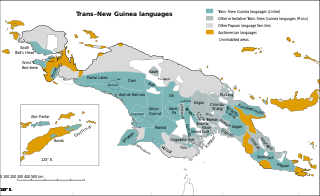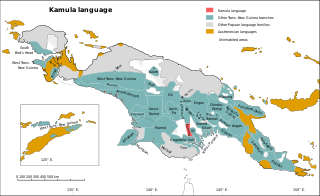
Trans–New Guinea (TNG) is an extensive family of Papuan languages spoken on the island of New Guinea and neighboring islands, a region corresponding to the country Papua New Guinea as well as parts of Indonesia.
The Senagi languages are a small family of Papuan languages in the classification of Malcolm Ross, that had been part of Stephen Wurm's Trans–New Guinea proposal. They consist of the two languages Angor and Dera.
The Karkar language, also known as Yuri, is the sole Eastern Pauwasi language of Papua New Guinea. There are about a thousand speakers along the Indonesian border spoken in Green River Rural LLG, Sandaun Province.
The Yalë language, also known as Yadë, Nagatman, or Nagatiman, is spoken in northwestern Papua New Guinea. It may be related to the Kwomtari languages, but Palmer (2018) classifies it as a language isolate.
Sulka is a language isolate of New Britain, Papua New Guinea. In 1991, there were 2,500 speakers in eastern Pomio District, East New Britain Province. Villages include Guma in East Pomio Rural LLG. With such a low population of speakers, this language is considered to be endangered. Sulka speakers had originally migrated to East New Britain from New Ireland.
Purari (Namau) is a Papuan language of Papua New Guinea.

The Kiwaian languages form a language family of New Guinea. They are a dialect cluster of half a dozen closely related languages. They are grammatically divergent from the Trans–New Guinea languages, and typically have singular, dual, trial, and plural pronouns.

The Turama–Kikorian languages are a family identified by Arthur Capell (1962) and part of the Trans–New Guinea languages (TNG) family in the classifications of Stephen Wurm (1975) and Malcolm Ross (2005). The family is named after the Turama River and Kikori River of southern Papua New Guinea; the alternative name is based more narrowly on the Omati River.
The Ottilien or Watam-Awar-Gamay languages languages are a small family of clearly related languages,

Sumuri or Sumeri is a language spoken in Sumuri District, Teluk Bintuni Regency on the Bomberai Peninsula by about a thousand people.

Kamula is a Trans–New Guinea language that is unclassified within that family in the classification of Malcolm Ross (2005). Noting insufficient evidence, Pawley and Hammarström (2018) leave it as unclassified.
Massep is a poorly documented Papuan language spoken by fewer than 50 people in the single village of Masep in West Pantai District, Sarmi Regency, Papua. Despite the small number of speakers, however, language use is vigorous. It is surrounded by the Kwerba languages Airoran and Samarokena.
Ipiko is a Papuan language of Papua New Guinea, the most divergent of the Inland Gulf languages. Despite being spoken by only a few hundred people, language use is vigorous. It is spoken in Ipiko and Pahemuba villages, with Ipiko village being located in Amipoke ward, Baimuru Rural LLG, Kikori District, Gulf Province.
The Lower Ramu or Ottilien–Misegian languages consist of two branches in the Ramu language family. They are all spoken in Yawar Rural LLG, Madang Province, Papua New Guinea.
Kambota.k.a.Ap Ma, is a Keram language of Papua New Guinea. Compared to its nearest relative, Ambakich, Kambot drops the first segment from polysyllabic words.
Yetfa and Biksi are dialects of a language spoken in Jetfa District, Papua, Indonesia, and across the border in Papua New Guinea. It is a trade language spoken in West Papua up to the PNG border.
Kire (Giri) is a Ramu language of Giri village in Yawar Rural LLG, Madang Province, Papua New Guinea.
Foia Foia (Foyafoya), or Minanibai, is a Papuan language of Papua New Guinea, spoken in an area near Omati River mouth in Ikobi Kairi and Goaribari Census districts.

The Papuan Gulf languages are a proposed language family of Papuan languages spoken inland from the large gulf that defines the shape of southern Papua New Guinea.
West Kikori Rural LLG is a local-level government (LLG) of Gulf Province, Papua New Guinea. Kiwaian languages are spoken in the LLG.






